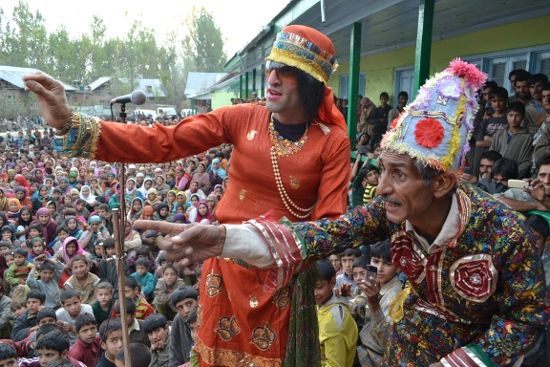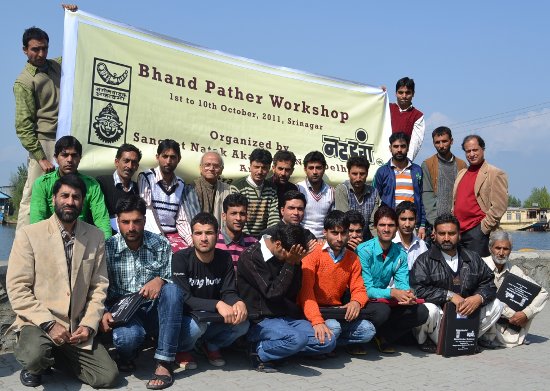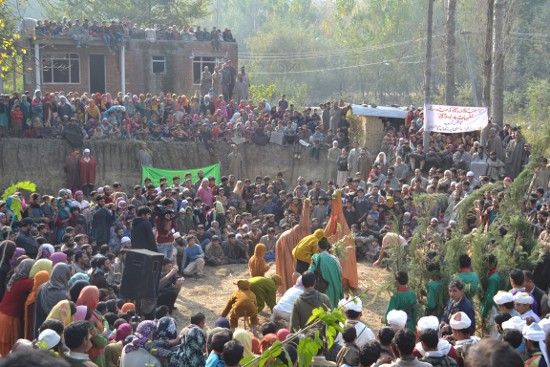
Cultural and social traditions and art forms in Kashmir have received huge set backs in the last 22 years of militancy. On such example is 'Bhand Pather', a traditional folk theatre. "Bhand Pather is the real face of Kashmir", says Balwant Thakur, a man whose passion for theatre and peace saw him take to the remote villages of Kashmir to revive the art form.
A dramatic form of storytelling, Bhand Pather is based on mythological stories and narratives most of which are of Hindu characters performed by Muslim actors. The stories incorporate characters and narrators that tell stories of contemporary social satire. The peformances use dry humour, satire full of irony and more often than not depict the triumph of good over evil.
This musical extravaganza, simple storytelling and laughter which travelled from village to village in Kashmir completely vanished in the violence and conflict that has prevailed in the valley in recent years.
We lost the merriment of crowds who used to gather in villages to watch and celebrate the diabolic being vanquished - says Thakur
A lost art form
Thakur runs Natrang, a popular theater group based in Jammu which has been going for 29 years. He decided to reopen the lost spaces and bring the crowds back to the village canvass and usher the resurgence of Bhand Pather, the soul of Kashmir.
While political parties, separatist, and religious organisations in Kashmir have been able to mobilize strong crowds during elections, political rallies, separatist speeches or religious sermons, cultural gatherings - perceived as symbols of normalcy and not linked to a particular cause - have became invisible.
No one dared to restart the tradition. Fear of the gun and being ostracised pushed the local performers and artist into deep silence - shares Thakur.Hence for him, being a Hindu Dogra from Jammu it has not been easy to go back to the valley and revive the artform. “I never had any inhibitions or fear. For me the underlying beauty of this form, the strength it carried for social change, people’s participation in public and to bring it back to the common person was a mission that compelled me to initiate this project. I have always felt deeply connected to the cultural forms of our region and to the people they belong to” shares Thakur. He adds, “I represent the artists and theatre is a tool that bridges people.”
Bringing Bhand Pather back to the valley

Khemu was exhilarated at the prospect of restoring Bhand Pather to its past glory. Together Thakur and Khemu had collective discussions followed by a ten day residential workshop in Gagribal in Srinagar, Kashmir. Local theatre folklorist and theatre personalities were involved in the workshop which had 20 representatives from 20 different theatre groups (which had been lying dormant) from 20 different villages in Kashmir.
The workshop resulted in 20 concepts on contemporary themes related to current reality in Kashmir. The themes were mostly associated with people’s suffering and experiences ranging from drugs, education, respect for elders exploitation, corruption and people’s aspirations for peace.
Theatre has a universal language and appeal. It transcends barriers and boundaries. Cultural programs can unite communities - stresses Thakur.
Overwhelming success

Indeed, Bhand Jashans bring back to the fore a common Kashmiris traditional forms and rootedness. Each Bhand Jashan from Kupwara, a border district near the Line of Control to Kulgam in South Kashmir, concluded with Bhand Dhuhai (prayer to almighty). “The performers together with villagers raised their hands in prayers saying let there be no disease and suffering in this village and all live in harmony, I felt that there was hope and peace would soon return to Kashmir”, said Thakur.
Thakur hopes to bring the Bhand Jashan once again this year with new groups and themes. He also wishes to take Bhand Pather and Rouf (Kashmiri folk dance) to the Jammu region and bring Jammu’s traditional Jagrana to Kashmir. “These traditional forms have people’s ownership. Government and other peace agencies have not utilized cultural as a connector for peace. I hope Natrang in spite of no resources or state patronage is able to carry forward this peace initiative”, says Thakur.











